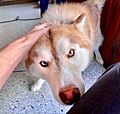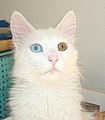Heterochromia facts for kids

Heterochromia is a cool word that means "different colors." Most often, it's used to describe when someone has eyes of different colors. This can happen to people and animals. Their irises (the colored part of the eye) might not match. Many things can cause this unique look.
Contents
Why Eyes Have Different Colors?
Sometimes, heterochromia is caused by genes. This can happen very early, even when a baby is forming inside its mother. Tiny changes in the cells that make the iris can lead to different colors. This is called genetic mosaicism.
Other times, something in the environment can cause it. An injury to the eye might change its color. Also, certain diseases or health problems can make eye colors different.
More Than Just Eyes
While we usually talk about heterochromia for eyes, it can happen in other body parts too. For example, a patch of skin or hair might be a different color. But it's easiest to see when it affects the iris of the eye.
When we specifically talk about eye color differences, people use terms like Heterochromia iridis. This means "different color of the iris."
Types of Heterochromia
There are a few main ways heterochromia can show up in eyes:
- Complete Heterochromia: This is when one eye is a completely different color from the other. For example, one eye might be blue and the other brown.
- Sectoral Heterochromia: In this type, only a part of one iris is a different color. Imagine a blue eye with a brown wedge or segment in it.
- Central Heterochromia: Here, the inner ring of the iris around the pupil is a different color from the outer part. For example, a blue eye might have a golden ring close to the pupil.
Is It Common?
Heterochromia is not super common in humans, but it's not rare either. Many famous people and even some of your friends might have it! It's more common in certain animal breeds, like Siberian Huskies or Turkish Angora cats.
For most people, heterochromia is harmless. It's just a unique and beautiful feature!
Images for kids
-
An Alaskan husky sled dog with heterochromia. Huskies are a breed known to have a high incidence of heterochromia.
-
Australian cricketer Shane Warne had complete heterochromia: his left eye was green and right eye was blue.
-
Professional baseball pitcher Max Scherzer has complete heterochromia: his right eye is blue and his left eye is brown.
-
Actress Kate Bosworth has complete heterochromia: her left eye is blue and her right eye is hazel.
-
Actor Dominic Sherwood has sectoral heterochromia.
-
Actor Henry Cavill has sectoral heterochromia.
-
Complete heterochromia in a Siberian Husky: one eye blue, one eye brown.
-
Sectoral hypochromia in a blue merle Border Collie.
-
A Turkish Angora cat with complete heterochromia.
See also
 In Spanish: Heterocromía para niños
In Spanish: Heterocromía para niños


















